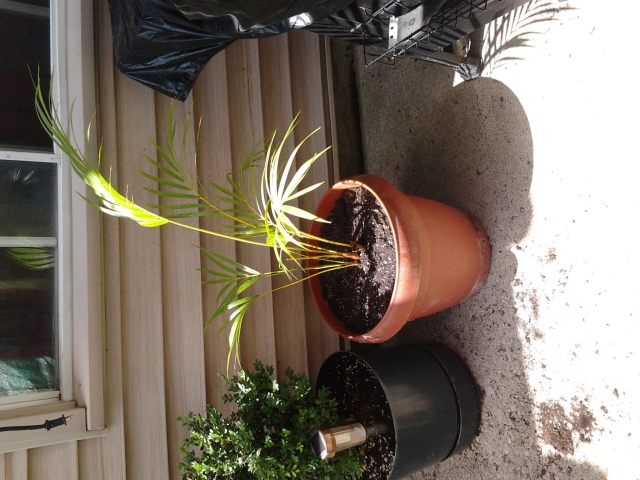Question Palm Plant
Palm Plant
QUESTION: I rescued a palm, tree/plant from my work place. It is about 1.5 feet high, but was kept in a 4 inch pot, and was extremely root bound.
I transplanted it into a much larger container, after loosening and cutting back on the root ball.
The stalks are yellow, but the fronds are green and there is also a new green shoot coming up from the base.
I was wondering what else I can do to make this plant thrive?
It is quite warm here, during the day, around 80F, so I have been keeping it outside. Is this ok?
I have been watering it a lot, and it seems to be just drinking in the moisture..
This is not the greatest of pictures, but perhaps you can distinguish as to what type of palm this is?
Thank you for any help you have
ANSWER: Hi Lisa,
Your plant is an Areca Palm. Its stems are naturally yellow and its fronds are green when healthy.
You made the very common mistake of over-potting it. The excess soil in the large pot will absorb and retain moisture for too long and eventually cause root rot. So the first thing you have to do is un-pot it and move it into the SMALLEST pot that the rootball will fit into snugly. Plants do best when they are kept moderately potbound.
You mentioned "cutting back" the rootball. I don't know exactly what you did, but when repotting, other than loosening the outer roots bit, it is best to leave the roots undisturbed. It is hard to assess how much impact your cutting of the roots will have.
If you keep your Areca Palm outdoors in the warmer months, then be sure it is in shade at all times. Outdoor direct sunlight is much too intense for it. Indoors it can be kept in a sunny location because indoor light is much less intense.
When properly potted, it is best to water it thoroughly as soon as the top half-inch of soil feels dry.
Watch for spider mites as this is a favored host for those critters. Fertilize sparingly at half-strength and only when the plant is growing vigorously.
I have written articles on repotting, plant pests and on Palm care that I will email for free to you (or anyone else) who emails a request to me at
[email protected]. I have also written an indoor plant care book in a PDF format that I can sell you if you contact me at my email address.
Please let me know if any of this is unclear or if you have any additional questions.
If this information has been helpful, please click the Rate Volunteer bar below and enter a rating and NOMINATION for me. I am a volunteer on this site so Ratings are the only compensation I receive for answering plant questions.
Need more information? Visit my website at:
A link to HorticulturalHelp.com
or email me at
[email protected] or call me at 917-887-8601 (EST)
Regards,
Will Creed, Interior Landscaper
Horticultural Help, NYC
Visit my website at: A link to HorticulturalHelp.com
---------- FOLLOW-UP ----------
QUESTION: I immediately repotted the palm plant, to a pot that it does fit snuggly into.
When I first transplanted it, the pot was so small that the roots had grown out of the holes, in the bottom, and were wrapping themselves around the pot. The only way, I felt, for me to get it out of the pot was to cut, two long straggly roots.I left the remaining roots, just loosening the ball some, it was pretty impacted and tight.
I have since brought it inside, and placed it in a sunny location.
When will I know when to repot it again? I have read where they are very slow growers and somewhat of a challenge to grow indoors considering their natural environment and such
AnswerHi Lisa,
Good that you downsized the pot for your Areca Palm. The minimal root cutting that you did initially should not cause any harm, although do expect some yellow fronds as a result of the shock of two repottings. Look for healthy new growth and focus on that, not yellowing of older fronds.
Arecas actually grow a bit faster than many Palm species. The best indicator of when to repot is waterng frequency. If the soil is dry enough to require a thorough watering more than twice per week, then the ratio of roots to soil is such that it is probably ready for a pot one size larger. The amount of foliage or the size of the plant above the soil is not a reliable indicator for repotting. It is possible that yours may never need repotting again.
You might benefit from my article on repotting that I mentioned in my first reply to you.
~Will






